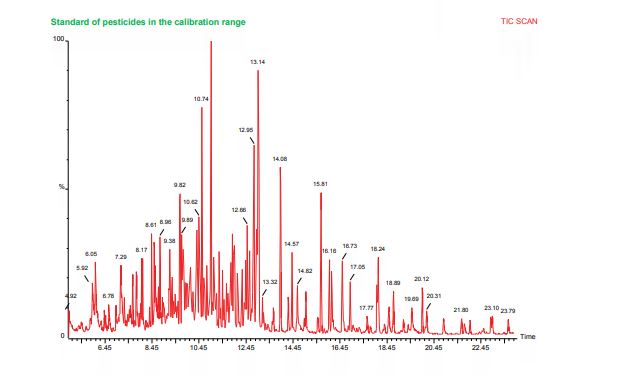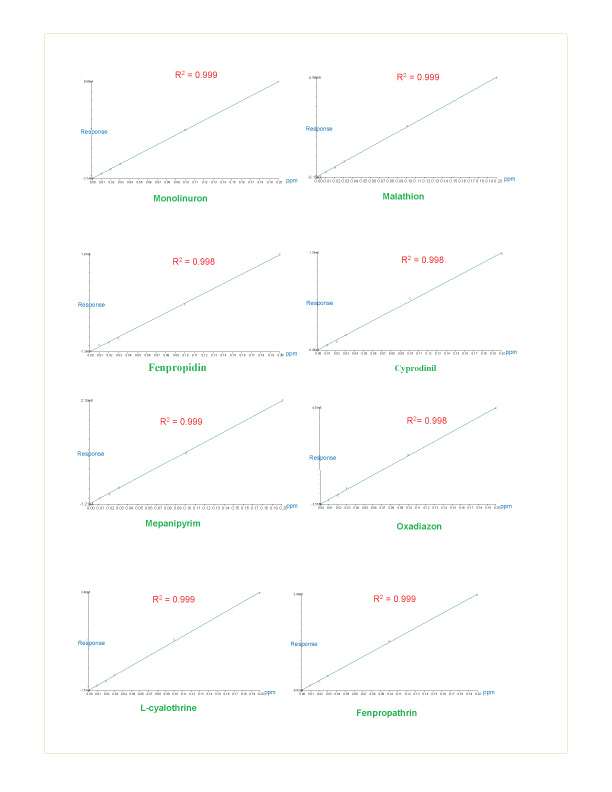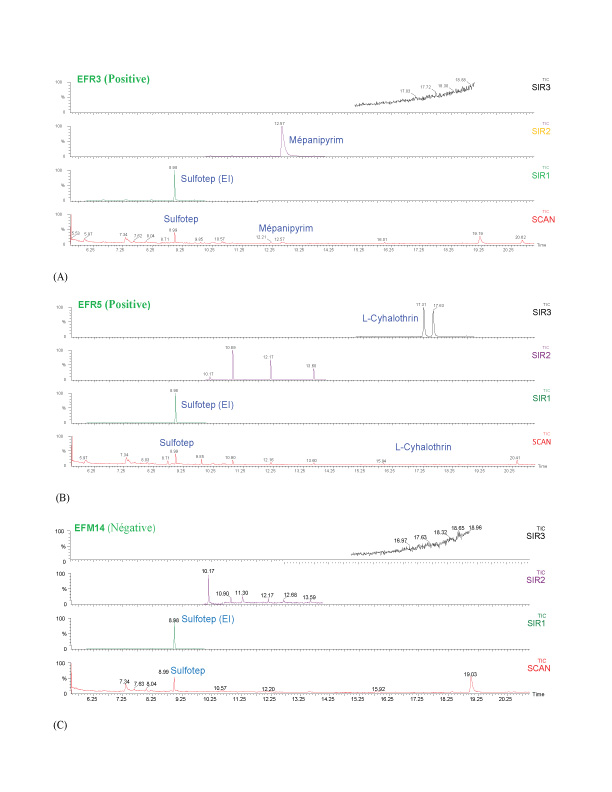Journal Name: Scholar Journal of Applied Sciences and Research
Article Type: Research
Received date: 08 July, 2019
Accepted date: 25 July, 2019
Published date: 30 July, 2019
Citation: Alami R, Jbilou M, Laarej K (2019) Development of A New Essay Method of Pesticides in Strawberries by GC-MS and Determination of their Residues in A Few Samples. Sch J Appl Sci Res Vol: 2, Issu: 9 (12-18).
Copyright: © 2019 Alami R. This is an open-access article distributed under the terms of the Creative Commons Attribution License, which permits unrestricted use, distribution, and reproduction in any medium, provided the original author and source are credited.
Abstract
Strawberries, fruits of the family Rosaceae (Fragaria vulgaris L), grown in Morocco in the regions of Souss, Gharb and Loukkos, are widely consumed because of their high vitamin content (C, B1, P and PP) and in mineral salts. This crop is very sensitive to parasites which requires treatments with pesticides to preserve the crop. Our job is to develop a new analytical method based on the extraction of pesticide residues from strawberries samples and their GC-MS assay. The sample preparation consists of crushing the fruit and weighing 10 g for extraction by the QuECHERS method and 3 μl of the extract are injected into the GC-MS. The recovery percentage of this method is 87.5%, the detection limits are 10 PPB and the linearity repetition coefficient is greater than 0.99. 17 samples taken on the market were analyzed by this method, the results showed that a sample is positive in Mepanipyrim.
Keywords: Pesticides, Strawberry, Essay and GC-MS.
Abstract
Strawberries, fruits of the family Rosaceae (Fragaria vulgaris L), grown in Morocco in the regions of Souss, Gharb and Loukkos, are widely consumed because of their high vitamin content (C, B1, P and PP) and in mineral salts. This crop is very sensitive to parasites which requires treatments with pesticides to preserve the crop. Our job is to develop a new analytical method based on the extraction of pesticide residues from strawberries samples and their GC-MS assay. The sample preparation consists of crushing the fruit and weighing 10 g for extraction by the QuECHERS method and 3 μl of the extract are injected into the GC-MS. The recovery percentage of this method is 87.5%, the detection limits are 10 PPB and the linearity repetition coefficient is greater than 0.99. 17 samples taken on the market were analyzed by this method, the results showed that a sample is positive in Mepanipyrim.
Keywords: Pesticides, Strawberry, Essay and GC-MS.
Introduction
The strawberry (Fragaria vulgaris L) [1], is a perennial plant native to America and belonging to the Rosaceae botanical family. It is of a high nutritional quality; rich in vitamins (C, B1, P and PP) and in mineral salts [2]. The main regions producing strawberries in Morocco are Souss, Gharb and Loukkos.
Strawberries are fruits and vegetables that are grown for a very short time of the year and consumed very quickly just after harvest and often without prior washing. The mode of their production above ground promotes the development of molds, hence the massive use of fungicides, but also insecticides especially for crops in economically viable conditions [3], which can lead to some risk for the presence of residues of these pesticides at the time of harvesting the fruit if the pre-harvest deadlines (DAR) corresponding to the pesticides used are not respected [4]. Apart from pesticides that are authorized by the National Office of Food Safety (ONSSA) for the cultivation of strawberry some farmers use other more toxic molecules [5] and therefore can significantly affect human health [6]. Our goal is to identify and measure pesticide residues by GC-MS in locally marketed strawberry samples and compare their results with the European Committee’s Maximum Residue Limits (MRL) [7], to inform consumers about the dangers of this uncontrolled production and marketing of strawberries in local markets.
Material and Method
Instrumentation
The gas chromatographic system coupled to the mass spectrometry used in this work is GC-MS Clarus 600/560 DMS PerkinElmer, equipped with an automatic injector. The system is driven by software Turbo Mass Software (Microsoft Windows XP SP2). The stationary phase is a supelco® column (L 30mx ID 0.25X DF 0.25) phase Elite-5MS
Reagents and chemicals
Pesticide standards used in calibration range are LGC Standards
• Acetonitrile, Toluene and acetic acid VWR brand.
• SPEXQuE QuEChERS Kits (Citrate Bufer Extraction Tubes).
• ULTRA QUECH (QUEC-208).
Calibration range
The preparation of the calibration range (0.01 ppm, 0.02 ppm, 0.03 ppm, 0.1 ppm and 0.2 ppm) was made from the stock solution of a mixture of 1ppm of 39 pesticides on a sample of organic strawberry, brought back of a vegetable and organic fruit trader in Rabat.
(Difluorobenzamide, Aminocarb, Chlomephos, Methiocarb, Ethoprophos, Chlorbufam, Monolinuron, Secbumeton, Iprobenfos, Pirimicarb, Benonacor, Chlorpyriphos desmethyl, Toclophos methyl, Malathion, Fenpropidin, Fenpropimorph, Parathion, Triadimephon, Pirimphos ethyl, Cyprodinil, Penconazol, Parathion, Zoxamide, Procmidon, Methidathion, Mepanipyrim, Flutiafol, Oxadiazon, Binapacryl, Ofurace, Trifloxystrobin, Spiromesifen, Fenpropathrin, Pyripoxyfen, L-cyalothrin, Fenarimol, Deltamethrin, Indoxacarb and Pyridaben) at 1 ppm by successive dilutions. Sulfotep was used as an internal standard and triphenilphosphate (TPP) as an external standard at 0.1 ppm each.
Collection and origin of strawberry samples
The strawberry samples were randomly selected from sales points in Rabat, Salé, Kenitra and Meknes. These samples were selected and coded according to their origins (Table 1).
Extraction by the method of QuECHERS
Extraction: Transfer 5-10 g of the homogenate from the strawberry sample into a 50 mL conical tube, add 10 mL of the acetinitrile solution to 1% acetic acid, 100 μL of the internal standard and mix. with the SPEXQuE Acetate Tube container (AOAC-ACE-50 mL). Vortex for 1 min and centrifuge at 3000 rpm for 5 min.
Purification: Transfer 1 mL to SPEXQuE PSA 2 mL tube (ULTRA QuECH-QUEC-208). Vortex for 1 min and centrifuge at 3000 rpm for 5 min. Fill a glass tube with 0.5 mL of the extract and evaporate to dryness under a stream of nitrogen. Resume the dry extract with 50 μl of toluene and vortex for 1 min. Transfer the extract into the injection vial and inject 3 μl into GC-MS in splitless mode.
Chromatographic conditions
The oven was programmed from 90°C up to 230°C at a gradient of 15 °C per min and then at 5°C per min up to 290°C with pre-heating of the transfer line to 300°C and the ionization source at 250°C. The automatic injection is in splitless mode (50/1 to 250°C). Ionization is caused by an electronic impact (IE) and the carrier gas is helium at the rate of 0.8 mL / min.
Results and Discussion
Chromatogram of the standard
After analysis, the chromatogram showing the peaks of the pesticides that make up the mixture was recorded in Figure 1, the detection limits (LD) are at 10 PPB and the numerical results; Standard concentration (Cc), Retention time (RT), detection and quantification (m/z) masses, Found concentration (Ct), and average parentage of extraction yield were shown in Table 2.
Linearity
Over a concentration range consisting of 5 levels of concentrations (0.01ppm, 0.02 ppm, 0.03 ppm, 0.1 ppm and 0.2 ppm), we studied the equation of the calibration line (Y=ax+b) of each pesticide and we computed by the least squares method over the entire range the satisfactory R2 repetition coefficients (Figure 2 and Table 3).
Determination of pesticide residues in strawberrys samples
The application of the pesticide assay method by GCMS on locally marketed strawberry samples showed the presence of Mepanipyrim residues at 0.016 mg / kg in EFR3 (MRL EUR 0.01 mg / kg) [7] and L-cyalothrin at 0.033 mg / kg in EFR5 (MRL EUR 0.20mg / kg) [5] (Figure 3 and Table 3). The exceedances of the tolerated limits come mainly from the bad methods of treatment of strawberry crops by certain farmers who do not respect the deadlines before harvests (DAR) recommended by the manufacturer [8]. Mepanipyrim is a toxic fungicide, acts effectively on gray mold (Botrytis cinerea) [9], however the persistence of these residues on fruit crops (strawberry) directly to local consumers can affect their health and generate cases of pathological diseases cancer [10]. L-cyalothrin is an insecticide that acts on the nervous system and the persistence of these residues in strawberries can lead to cases of human neurotoxicity [11] and could affect the development of the child’s nervous system [12] (Table 4).
| Strawberries codes | Dates | Quantities | Nature |
|---|---|---|---|
| EFR1 | 06.02.2019 | 250 g | Ripe strawberries |
| EFR2 | 13.02.2019 | 250 g | Ripe strawberries |
| EFR3 | 10.02.2019 | 250 g | Ripe strawberries |
| EFR4 | 10.02.2019 | 125 g | Ripe strawberries |
| EFR5 | 13.02.2019 | 125 g | Ripe strawberries |
| EFS6 | 20.02.2019 | 125 g | Ripe strawberries |
| EFS7 | 22.02.2019 | 125 g | Ripe strawberries |
| EFS8 | 10.02.2019 | 125 g | Ripe strawberries |
| EFS9 | 01.03.2019 | 125 g | Ripe strawberries |
| EFK10 | 05.03.2019 | 125 g | Ripe strawberries |
| EFK11 | 09.02.2019 | 250 g | Ripe strawberries |
| EFK12 | 15.02.2019 | 250 g | Ripe strawberries |
| EFK13 | 26.02.2019 | 250 g | Ripe strawberries |
| EFM14 | 28.02.2019 | 250 g | Ripe strawberries |
| EFM 15 | 30.03.2019 | 250 g | Ripe strawberries |
| EFM 16 | 15.03.2019 | 250 g | Ripe strawberries |
| EFM 17 | 15.03.2019 | 250 g | Ripe strawberries |
Table 1: Origins of strawberry samples.
| Pesticides | Cc (ppm) | TR (min) | Masses pics (m/z) | Pics Qt (m/z) | Ct (ppm) |
|---|---|---|---|---|---|
| Difluorobenzamide | 0.1 | 06.06 | 141.113.63 | 141 | 0.07 |
| Aminocarb | 0.1 | 06.29 | 151.150.136 | 151 | 0.07 |
| Monolinuron | 0.1 | 09. 48 | 61.46.126 | 61 | 0.08 |
| Pirimicarb | 0.1 | 10.12 | 72.166.42 | 72 | 0.09 |
| Toclophos méthyl | 0.1 | 10.47 | 265.125.93 | 265 | 0.06 |
| Malathion | 0.1 | 10.61 | 93.173.125 | 93 | 0.09 |
| Fenpropidin | 0.1 | 11.04 | 97109.139 | 97 | 0.08 |
| Fenpropimorph | 0.1 | 11.13 | 128.129.117 | 128 | 0.08 |
| Pirimphos ethyle | 0.1 | 11 .47 | 168.152.180 | 168 | 0.09 |
| Cyprodinil | 0.1 | 11.63 | 224.225.77 | 224 | 0.08 |
| Penconazol | 0.1 | 11.82 | 159.248.161 | 159 | 0.07 |
| Parathion | 0.1 | 11.99 | 109.97.125 | 109 | 0.07 |
| Zoxamide | 0.1 | 12.04 | 187.242.189 | 187 | 0.10 |
| Procymidon | 0.1 | 12.09 | 96.67.53 | 96 | 0.08 |
| Méthidathion | 0.1 | 12.27 | 85.145.93 | 85 | 0.06 |
| Mepanipyrim | 0.1 | 12.46 | 222.223.77 | 222 | 0.07 |
| Flutriafol | 0.1 | 12.62 | 123.164.95 | 123 | 0.08 |
| Oxadiazon | 0.1 | 12.93 | 41.43.175 | 41 | 0.10 |
| Clodinafop | 0.1 | 13.04 | 238.266.130 | 238 | 0.08 |
| Binapacryl | 0.1 | 13.36 | 83.55.84 | 83 | 0.10 |
| Trifloxystrobin | 0.1 | 14.55 | 116.131.59 | 116 | 0.08 |
| Spiromesifen | 0.1 | 15.68 | 57.99.71 | 57 | 0.09 |
| Fenpropathrin | 0.1 | 16.15 | 97.55.43 | 97 | 0.10 |
| Pyripoxyfen | 0.1 | 17.06 | 136.78.96 | 136 | 0.06 |
| L-cyalothrine | 0.1 | 17.10 | 181.197.208 | 181 | 0.07 |
| Pyridaben | 0.1 | 18.87 | 147.117.132 | 147 | 0.07 |
| Indoxacarb | 0.1 | 23.02 | 59.203.150 | 59 | 0.06 |
| Average parenting performance | 87.50% | ||||
Table 2: Analytical Parameters of Mixture Pesticides.
| Pesticides | Y=(ax+b) | R² |
|---|---|---|
| Difluorobenzamide | 0.0103x+0.0065 | 0.997 |
| Aminocarb | 0.0097x+0.0104 | 0.995 |
| Monolinuron | 0.0115x+0.0144 | 0.999 |
| Pirimicarb | 0.0093x+0.0065 | 0.998 |
| Toclophos méthyl | 0.0083x+0.0065 | 0.998 |
| Malathion | 0.0153x+0.0065 | 0.999 |
| Fenpropidin | 0.0118x+0.0065 | 0.998 |
| Fenpropimorph | 0.0093x+0.0065 | 0.996 |
| Pirimphos ethyle | 0.0115x+0.0065 | 0.998 |
| Cyprodinil | 0.0033x+0.0065 | 0.998 |
| Penconazol | 0.0190x+0.0065 | 0.991 |
| Parathion | 0.0188x+0.0065 | 0.998 |
| Zoxamide | 0.0119x+0.0065 | 0.995 |
| Procymidon | 0.0183x+0.0065 | 0.994 |
| Méthidathion | 0.0098x+0.0065 | 0.994 |
| Mepanipyrim | 0.0140x+0.0065 | 0.999 |
| Flutriafol | 0.0091x+0.0065 | 0.997 |
| Oxadiazon | 0.0100x+0.0065 | 0.998 |
| Clodinafop | 0.0106x+0.0065 | 0.995 |
| Binapacryl | 0.0130x+0.0065 | 0.997 |
| Trifloxystrobin | 0.0105x+0.0065 | 0.997 |
| Spiromesifen | 0.0095x+0.0065 | 0.995 |
| Fenpropathrin | 0.0111x+0.0065 | 0.999 |
| Pyripoxyfen | 0.0133x+0.0065 | 0.998 |
| L-cyalothrine | 0.0114x+0.0065 | 0.999 |
| Pyridaben | 0.0166x+0.0065 | 0.998 |
| Indoxacarb | 0.0139x+0.0065 | 0.993 |
| Deltamethrine | 0.0167+0.0065 | 0.995 |
Table 3: Results of linearity.
Figure 1: Chromatogram of the standard.
| Strawberries codes | Search | Dosage | MRL EU | DAR | Interpretations |
|---|---|---|---|---|---|
| EFR1 | < LD | - | - | - | - |
| EFR2 | < LD | - | - | - | - |
| EFR3 | Mepanipyrim | 0.016 mg/kg | 0.010 mg/kg | 3 days | > LMR UE |
| EFR4 | < LD | - | - | - | - |
| EFR5 | L-cyalothrine | 0.033 mg/kg | 0.200 mg/kg | 7 days | <LMR UE |
| EFR6 | < LD | - | - | - | - |
| EFR7 | < LD | - | - | - | - |
| EFR8 | < LD | - | - | - | - |
| EFR9 | < LD | - | - | - | - |
| EFR10 | < LD | - | - | - | - |
| EFR11 | < LD | - | - | - | - |
| EFR12 | < LD | - | - | - | - |
| EFR13 | < LD | - | - | - | - |
| EFR14 | < LD | - | - | - | - |
| EFR15 | < LD | - | - | - | - |
| EFR16 | < LD | - | - | - | - |
| EFR17 | < LD | - | - | - | - |
Table 4: Dosage Results of Pesticide Residues in Strawberry Samples by GCMS.
Figure 2: Examples of calibration lines for mixed pesticides.
Figure 3: Chromatograms of the samples (A, EFR3, B, EFR5 and C, EFM14).
Conclusion
The determination of pesticide residues by GC-MS in locally marketed strawberry samples has shown that these fruits are contaminated with pesticide residues; L-cyalothrin at a concentration lower than European standards and Mepanepirim at a concentration above European standards, This study is only preliminary and should be extended to other regions of Morocco to take the necessary measures to preserve health consumers.
Pysalo T (1972) Volatiles of wild strawberries, Fragaria vesca L compared to those of cultivated berries, Fragaria times ananassa cv Senga Sengana. J Agric Food Chem 27: 19-22.[ Ref ]
Perez AG, Rios JJ, Sanz C, Olias JM (1992) Aroma components and free amino acids in strawberry variet Chandler during ripening. Journal of Agricultural and Food Chemistry 40: 2232-2235.[ Ref ]
Bourguignon D (2017) Politique et législation de l’UE sur les pesticides - Produits phytopharmaceutiques et biocides. EPRS Servicede recherche du Parlement européen, avril. [ Ref ]
Novethic (2012) Les Français toujours très exposés aux pesticides.[ Ref ]
Tabashnik BE, Brévault T, Carrière Y (2013) Insect resistance to Bt crops: lessons from the first billion acres. Nature Biotechnology 31: 510-521.[ Ref ]
Jaeger (2001) Exposition chronique aux pesticides, santé et longévité. Revuegénérale; Rôle de notre alimentation (Chronic pesticide exposure, health and longevity. Role of our food). Médecine & Longévité; pp: 06-22.[ Ref ]
L’article 8.4 de la directive 91/414/CE concernant la mise sur le marché de produits phytopharmaceutiques et l’article 53 du règlement (CE) no 1107/2009 concernant la mise sur le marché des produits phytopharmaceutiques.[ Ref ]
Eddleston M (2002) Pesticide poisoning in the developing world a minimum pesticides list. The Lancet 360: 1163-1167.[ Ref ]
Krämer W, Schirmer U, Jeschke P (2012) Matthias Witschel: composés de protection des cultures modernes. John Wiley & Sons.[ Ref ]
Alavanja MCR, Bonner MR (2012) Occupational pesticide exposures and cancer risk: A review. Journal of Toxicology and Environmental Health - Part B: Critical Reviews 15: 238-263.[ Ref ]
Baldi I (2012) maître de conférences et praticien hospitalier au Laboratoire Santé-Travail-Environnement (LSTE) de l’Université Bordeaux II.[ Ref ]
Maternal-child exposure via the placenta to environmental chemical substances with hormonal activity conduite à l’Université de Grenade par Maria José Lopez.[ Ref ]





